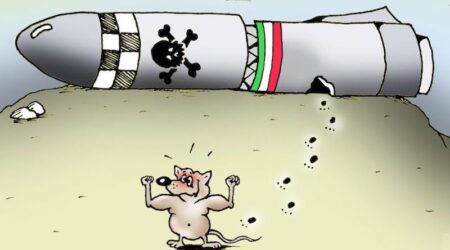Purim and Stalin’s Jewish Deportation Plan
The early months of 1953 were a bad time to be a Jew in the USSR. Less than a decade earlier, the Nazis and their allies had just finished murdering almost 1.5 million Soviet Jews.
Now rumors were circulating that the Soviet government, whose army had liberated Auschwitz and helped put an end to the Third Reich, was planning to round up its remaining 2 million Jews and ship them off to concentration camps in Siberia and other parts of the Soviet Far East.

Historians debate the existence of this deportation plan to this day, but the paranoia and fear among Soviet Jews that fueled these rumors was well-founded. As early as the 1939 Molotov–Ribbentrop Pact, which led Stalin to purge Jews from the state apparatus and send Jewish refugees back to Germany to appease the Nazis, the Soviet government had shown its willingness to sacrifice its Jews for the perceived interests of the party and the state. Despite the half a million Jews who fought against the Axis powers in the Red Army (one-third of whom perished), Stalin’s government embarked on a widespread postwar anti-Semitic campaign to drive Jews out of the Communist Party, MGB (the KGB’s predecessor), Ministry of Foreign Affairs, and prestigious and ideologically-sensitive fields like theater, literature, journalism, and even medicine and the hard sciences.
Members of the Jewish Anti-Fascist Committee, who helped raise funds for the Soviet war effort, were liquidated. Thirteen of the greatest Yiddish writers in the nation were executed in one day on what came to be known as the Night of the Murdered Poets. The euphemistically titled campaign against “rootless cosmopolitans” peddled in state newspapers gave institutions of labor and learning throughout the nation carte blanche to drive out its Jews and keep them out. Then, in January of 1953, Pravda exposed the so-called Doctors’ Plot, which accused a group of Soviet Jewish doctors of plotting to poison high-ranking Soviet officials with the aid of the American Jewish Joint Distribution Committee, a real nonprofit philanthropic entity accused by the Soviets of being an “international Jewish bourgeois-nationalist…Zionist spy organization.”
Rumors circulated that Stalin was planning to hang the “poisoner-doctors” in public to unleash a preplanned pogrom against Soviet Jews, who he would then save from this apparently spontaneous public wrath by deporting them en masse to the east. Then, on March 1, Stalin suffered a stroke that led to his death four days later. March 1 that year fell on the 14th day of the month of Adar in the Hebrew calendar, a day on which Jews around the world had celebrated the festival of Purim for over 2000 years.
Stalin, a former seminarian, might have intended to present himself as a modern-day Ahasuerus saving Soviet Jews from their would-be murderers by sending them east, as he did during WWII by evacuating Jews from the western Soviet Socialist Republics ahead of the invading Nazis before leading the Red Army to victory over the Third Reich. Some contemporary Jews initially even bought this spin, weeping for the man who helped put an end to the Holocaust. But after the de-Stalinization that followed Khrushchev’s 1956 speech denouncing his predecessor’s personality cult and the revelations in the decades that followed about the millions of lives lost and destroyed in Uncle Joe’s gulags and purges, Stalin is now firmly seen by Soviet Jews and those who fought for their liberation as a modern-day Haman, thwarted just before he could wreak havoc on the millions of Jews in his power.
On some level, whether or not Stalin actually had a concrete plan to cleanse Soviet Europe of its Jews is secondary to the overwhelming sense that most Soviet Jews felt of having been saved from another genocide less than a decade after the Holocaust. In the following decades, however, Soviet Jews continued to face widespread discrimination in employment and education while the government prohibited all but the most nominal manifestations of Jewish culture and learning. While the threat of ethnic cleansing passed with Stalin, the state continued to do everything in its powers to suppress any expression of Jewish or Zionist pride. All of this from a government that presented itself as the leader of the world’s progressive movement, one that claimed to stand against racism, imperialism, and fascism and ostensibly championed progressive values like world peace, gender equality, and ecological conservation. Stalin and his communist successors showed the world that self-proclaimed progressives were just as capable of engaging in widespread, all-encompassing anti-Semitism as their fascist counterparts.
In the decades since the collapse of the USSR, some Soviet Jews have begun to observe a special Purim (a Jewish tradition going back at least a millennium) commemorating their deliverance from Stalin and his henchmen. And yet, perhaps because this special Purim coincides with the universal one or because Soviet Jews were forbidden from celebrating Purim at all for decades after Stalin’s death, it remains little known outside of the Soviet Jewish community and those that were actively involved in the struggle to free Soviet Jewry.
We celebrate Purim this year—5780 according to the Jewish calendar and 2020 according to the Christian—at a time when anti-Semitism in the west has reached levels unseen since the Holocaust. Moreover, this year the United States will conduct a presidential election for the first time in history with a major candidate, Bernie Sanders, who is nostalgic for the policies and accomplishments of the Soviet Union. Now, more than ever, it is important to remember this particular special Purim that commemorates a time in recent memory when a government ostensibly dedicated to progressive values planned to destroy its sizable Jewish population under a leader that many Jews looked to as a savior, when he was actually one of the greatest threats to their existence.
Oleg Ivanov is a Candidate In Philosophy at UCLA writing his dissertation on Stalin’s Jewish deportation plan in media and memory. He is also a member of the Jewish Diplomatic Corps of the World Jewish Congress.
By Oleg Ivanov





